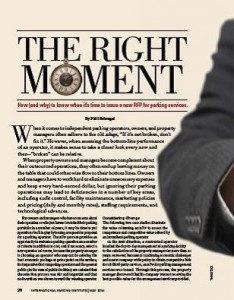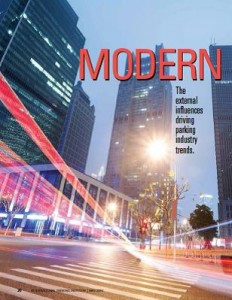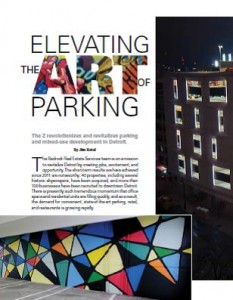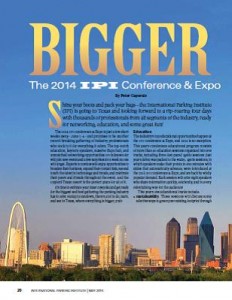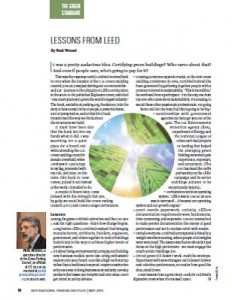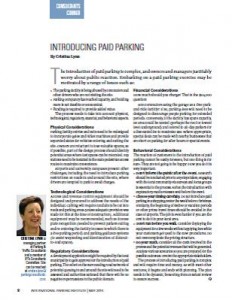Thinking Ahead
By Sanjay Pandya, PE
Facilitating immediate or future adaptive reuse of parking structures.
Technology and advances in society are affecting current thinking related to mobility and 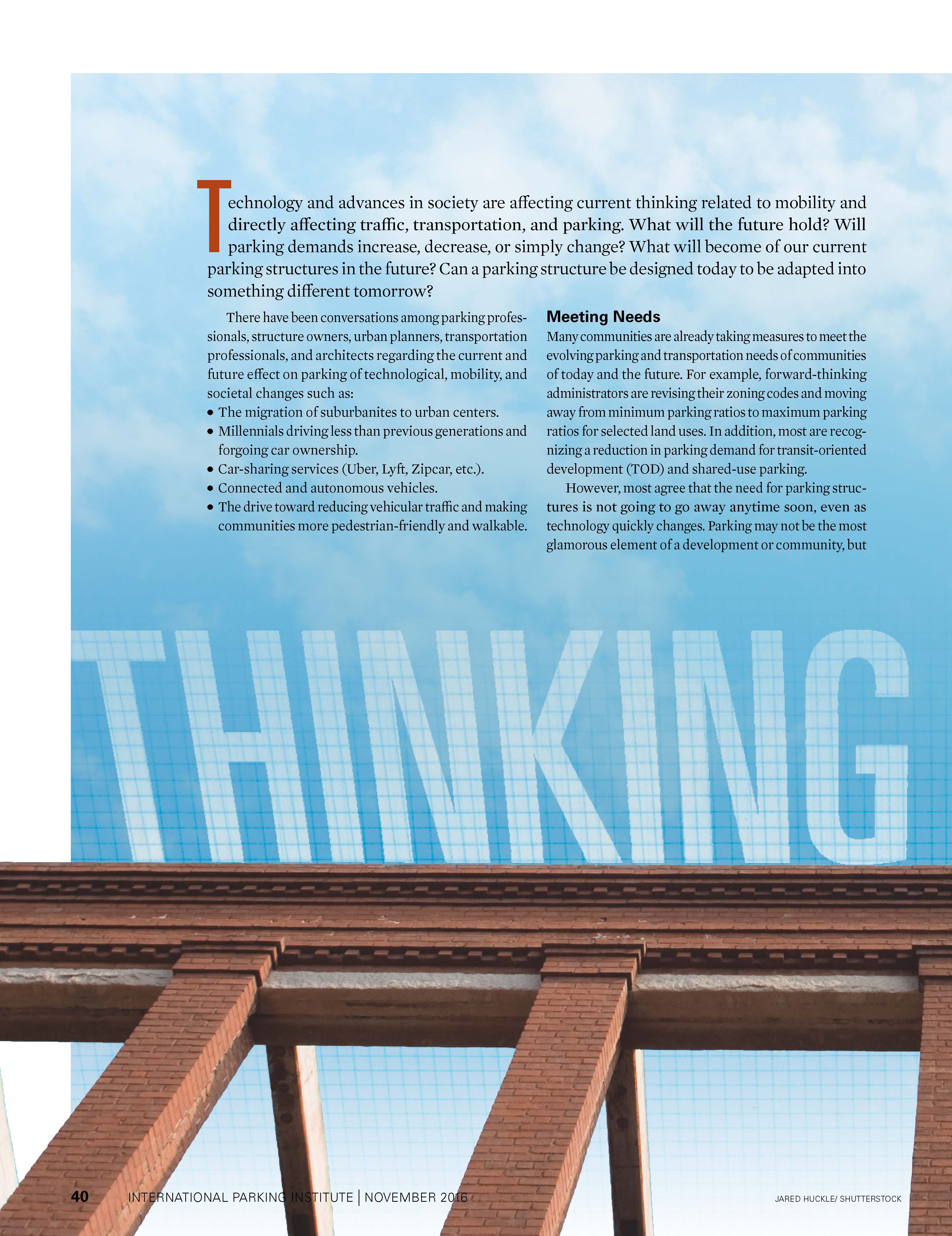 directly affecting traffic, transportation, and parking. What will the future hold? Will parking demands increase, decrease, or simply change? What will become of our current parking structures in the future? Can a parking structure be designed today to be adapted into something different tomorrow?
directly affecting traffic, transportation, and parking. What will the future hold? Will parking demands increase, decrease, or simply change? What will become of our current parking structures in the future? Can a parking structure be designed today to be adapted into something different tomorrow?
There have been conversations among parking professionals, structure owners, urban planners, transportation professionals, and architects regarding the current and future effect on parking of technological, mobility, and societal changes such as:
- The migration of suburbanites to urban centers.
- Millennials driving less than previous generations and forgoing car ownership.
- Car-sharing services (Uber, Lyft, Zipcar, etc.).
- Connected and autonomous vehicles.
- The drive toward reducing vehicular traffic and making communities more pedestrian-friendly and walkable.
Meeting Needs
Many communities are already taking measures to meet the evolving parking and transportation needs of communities of today and the future. For example, forward-thinking administrators are revising their zoning codes and moving away from minimum parking ratios to maximum parking ratios for selected land uses. In addition, most are recognizing a reduction in parking demand for transit-oriented development (TOD) and shared-use parking.
However, most agree that the need for parking structures is not going to go away anytime soon, even as technology quickly changes. Parking may not be the most glamorous element of a development or community, but many community planners and developers recognize that when it’s done right, parking is key to realizing their vision for an active and vibrant community and a successful development.
The service life of many parking structures being designed now is typically about 50 to 75 years. As a result, these buildings are and will continue to be fixtures of our communities’ urban landscape. However, we are realizing that with time, our mobility options and preferences are going to change. The needs of the urban community are going to change. The last thing anyone wants or needs is to build a structure that will be obsolete or severely underutilized.
What if parking structures could be designed to not only handle current needs but also adapt to better meet the evolving parking and transportation needs of communities in the future? What if we could future-proof the parking structure of today and design it to be adaptable to become a community mobility hub, a community event center, or even some other type of land use? Can this be done physically and economically?
Designing to Adapt
I believe it can be done for a new parking structure design, and it may also be possible for an existing structure retrofit. Some would argue that it would be simpler and less costly to demolish an existing parking structure and replace it with a new building more suitable for the new use. But in some circumstances and for many owners taking the long view, this may not be the most environmentally responsible or cost-effective choice. So how do we go about doing this in a creative and economical way? What should we consider and do today to allow parking structures to be multifunctional and adaptable in the future?
The Challenge
Parking structures are unique building types. They are typically open to the environment and are designed to be storage facilities (group S occupancy); they’re generally not conditioned, occupied spaces. They are typically more horizontal than vertical in configuration. The primary focus of parking structure design has been to efficiently move cars in, store them, and then move them back out efficiently. In contrast, buildings for non-parking uses focus on making the occupied space safe, habitable, appealing, and accessible for people. There are a number of design features of a parking structure that don’t lend themselves to non-parking uses:
- Story heights. Typically, parking structure story heights range between 10 feet and 11 feet, six inches. Those measurements are not suitable for most commercial office/retail or residential uses.
- Sloped floors. Parking structures require sloped floors to facilitate vehicular circulation between parking levels and for drainage.
- Size, number, and layout of stairs and elevators. Stairs are a means of egress for life safety and are sized based on code-prescribed occupant load factor associated with an occupancy use classification. For parking structures, the occupant load factor is 200 square feet per person, whereas for an office (Group B) and mercantile (Group M) occupancy it is 100 and 60 square feet per person, respectively, resulting in the requirement for wider stair widths and/or additional stairs. Stairs and accompanying elevators are typically located along the perimeter of a parking structure, whereas in non-parking use buildings, they are typically located within the interior of the building footprint.
- HVAC systems are not provided for parking floor areas.
- Many jurisdictions don’t require parking structures to have fire sprinklers for fire protection but do require the systems in other kinds of buildings.
- The minimum code-prescribed floor live loading for parking structures is 40 pounds per square foot. For other uses such as office, retail, library reading rooms, public meeting space and their corridors, the requirement is between 50 and 100 pounds per square foot.
Possible Solutions
So what can be done differently when planning for and designing the parking structure of the future to compensate for these standard parking structure design features? Plenty:
Increase story heights. We could make the height of the first story a minimum of 15 feet and the height of typical upper stories 12 feet. These heights are more suitable to provide higher clear heights of 12+ feet for ground-level commercial/retail use and 9+ feet for office, community meeting, or possibly residential use. If sufficient site length is not available to provide a parked on-ramp with these story heights or more flat floor area is desired than non-parked-on express ramps (with slope greater than 6.67 percent) could be provided for a portion or the entire length of a ramp. These ramps could be situated near ends of the floor plate or along its sides to provide for more flat floor area.
- Design the floor framing to allow for the ramped parking bay to be more readily demolished. One way to accomplish this is to provide a double row of columns along the bay with the ramp and expansion/construction joints at the top and bottom of each floor-to-floor ramp segment. This would likely require additional framing elements for lateral load resistance and detailing to facilitate load transfer and accommodate building movement at the expansion/construction joints. While this would add to the initial construction costs, it would also provide an opportunity for modifying each floor to be a complete flat floor plate for future uses.
- Include 25- to 30-feet-wide light wells between parking bays to provide space for the construction of additional elevator and stair cores and flat-floor construction for corridors within the interior of the building footprint. Foundations for these future pedestrian circulation elements could be constructed as part of the initial construction.
- The perimeter stair and elevator cores that serve the parking structure could be located outboard to the floor plate. This would allow for easier demolition of these elements if they don’t adequately serve the alternate use.
- Design floor framing for additional load-carrying capacity by including provisions for adding columns and beams to reduce beam and slab spans or supplement conventional and post-tensioned slab and beam reinforcement to support additional floor loads. This additional load-carrying capacity could accommodate a topping slab to level out the floor drainage slope.
- The impacts of floor cross slope for drainage could be reduced by providing additional floor drains.
- Building columns, walls, and foundations could be designed to accept vertical expansion and the addition of a podium level for a public plaza recreational space or a one- or two-story light-framed (type 5 framed wood construction) building structure.
- Design for either the removal of perimeter vehicle and pedestrian guard rails or detail connection points to accept future installation of building facade elements (e.g., curtain wall/store front system, panelized EIFS, or stucco wall system, etc.), including doors and windows to fully enclose the perimeter of the structure.
- Provide additional capacity in the electrical service, sanitary sewer, and fire protection systems. Include provisions for electrical and mechanical chases to accommodate duct work and cabling and additional space for mechanical and electrical service and fire protection equipment (fire pumps, emergency generators, etc.).
These are just some provisions that would need to be considered and addressed in the design of new parking structures to provide the opportunity for the structures to be adapted for non-parking uses in the future. Additional structural and architectural consideration may need to be identified based on whether the parking structure is constructed of cast-in-place concrete, precast concrete, or steel-framed construction.
I recognize that not all projects will lend themselves to implementing design enhancement for facilitating future adaptive reuse, but for some projects and owners, it may be beneficial to investigate the possibilities during project planning and design development. Parking structures designed in this manner to accommodate future conversion to a different use will cost more initially. The economic decision to proceed in this manner will need to be considered by community leaders and owners to determine the feasibility of such an investment for our environment and communities.
What do you think? Please share your thoughts and feedback—my email address is to the right.
SANJAY PANDYA is a parking practice builder and senior project manager with Kimley-Horn. He can be reached at sanjay.pandya@kimley-horn.com.

